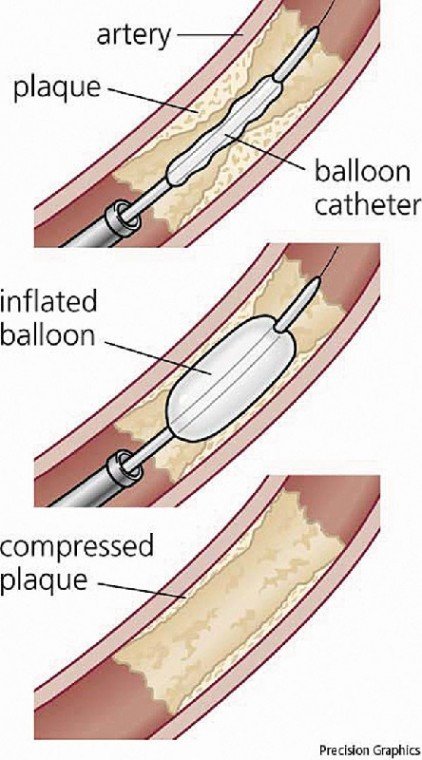Percutaneous transluminal coronary angioplasty might trip the
tongue, but it helps the blood flow smoothly.
PTCA, commonly known simply as angioplasty, is a procedure used
to widen clogged arteries. The goal is to improve blood flow to the
heart or other muscles, reduce the need for medication or reduce
chest pain.
Percutaneous transluminal coronary angioplasty might trip the tongue, but it helps the blood flow smoothly.
PTCA, commonly known simply as angioplasty, is a procedure used to widen clogged arteries. The goal is to improve blood flow to the heart or other muscles, reduce the need for medication or reduce chest pain. Angioplasties are recommended for people with significantly clogged arteries who are at risk of having a heart attack.
Healthy arteries are flexible and smooth, and blood is able to flow freely to the heart. Arteries become stiff and narrow when fat and cholesterol accumulate inside and form plaques.
Angioplasty is performed by a heart specialist, or cardiologist. The doctor first inserts a catheter through the skin into the narrowed part of the artery. The catheter has a deflated balloon attached to the end, and often, also attached is a spring-like wire mesh tube, called a stent.
Once the catheter is inside the artery, the doctor inflates the balloon, causing the blood vessel to expand and the blood to flow more easily. When the balloon inflates, if there is a stent attached, it also expands and locks into place inside the artery.
The stent stays in the artery permanently to hold it open and improve blood flow to the heart after the procedure is finished.
Sometimes, stents are coated with medication that slowly is released into the bloodstream to prevent arteries from narrowing again.
The final step of the procedure is removing the catheter and balloon. The entire process usually takes about 30 minutes to several hours, depending on how many arteries are being treated. The cost generally is anywhere between $8,000 and $25,000.
Neither Saint Louise Regional Hospital in Gilroy nor Hazel Hawkins Memorial Hospital in Hollister performs angioplasties, but the hospitals refer patients who need the procedure to other nearby facilities.
Dr. Patrik Zetterlund, a cardiologist at Salinas Valley Memorial in Salinas, said angioplasties are a very common – and easier – alternative to bypass surgery. Out of the 700 or so procedures he performs each year, Zetterlund said roughly 300 are angioplasties.
“It’s the treatment of choice for people who come in with heart attacks,” he said. “It’s less invasive than other means of restoring blood to the arteries, such as open-heart surgery.”
Although angioplasties can be performed with just the balloon and no stent, Zetterlund said it’s uncommon.
“The artery is a living thing, and it would like to close back down again,” he said. “The stent is like a metal scaffold that pulls it open. The vast majority of patients use stents in their procedures.”
Many patients opt for angioplasties also because the procedure does not require general anesthesia, major complications are uncommon and because the catheter is inserted through the skin, a major incision isn’t required, Zetterlund said.
“It’s an outpatient procedure, and most patients go home within a few hours. There’s standard follow-up. We see a patient within a week to make sure the access site has healed up,” he said.
But much of the procedure’s follow-up can’t be contained in a single visit to the doctor, Zetterlund said. Often, it involves a change in lifestyle.
“A lot of it is looking at why in the first place the patient had the need for an angioplasty and addressing those issues, such as quitting smoking, following dietary guidelines and exercising,” he said. “All the things we know we should be doing, but maybe aren’t.”
If the unhealthy behaviors continue, patients who have undergone angioplasties might experience narrowed arteries again within months, necessitating another angioplasty and possibly open-heart surgery.













